In our campaign to #imagemorehorses we present a complex and unusual case in which multimodal imaging facilitated a rapid and accurate diagnosis.
History
A 6 year old Irish sports horse with a history of grade 3/5 left hind lameness. The lameness had improved following an abaxial sesamoid nerve block. Radiographs taken by the referring vet had revealed an abnormal lucency in the distal phalanx and MRI was recommended for further investigation.
MRI findings
- Marked dilatation of the lateral vessels of the distal phalanx with surrounding fluid signal and sclerosis of the lateral half of the distal phalanx as well as marked thickening of the lateral plantar process, with aberrant vascular channels within this. The fluid signal within the bone may indicate that active modelling is ongoing.
- Mild to moderate fluid signal within the navicular bone, likely consistent with altered loading of the bone.
- Moderate distal interphalangeal joint effusion, which is a non-specific sign and may be secondary to other inflammation within the foot.
- Mild distal interphalangeal joint osteoarthropathy.
Differential diagnoses for the dilated vasculature include
- Marked chronic pedal osteitis, with possible thrombosis and secondary dilatation of the vascular channels
- Aneurysm of the lateral half of the proper plantar digital artery, with formation of collateral circulation
- Aneurysmal bone cyst (less likely).
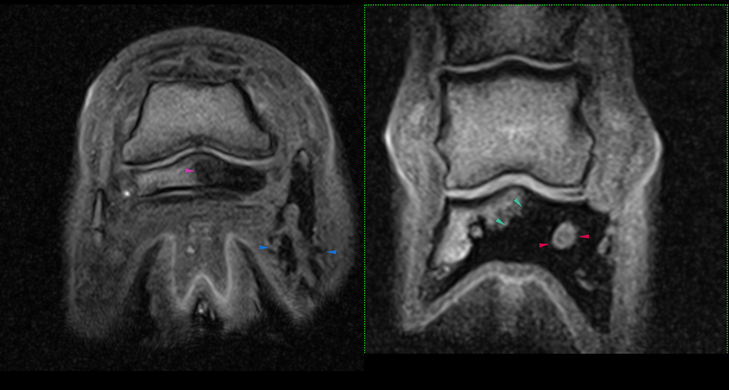
Frontal and transverse images of the left hind foot. The dilated foramen of the plantar digital artery is indicated by the red arrows. The extent of signal alteration within the distal phalanx is indicated by the green arrows. The enlarged lateral plantar process of the distal phalanx is indicated by the blue arrows. The signal alteration in the lateral half of the navicular bone can be appreciated (pink arrows).
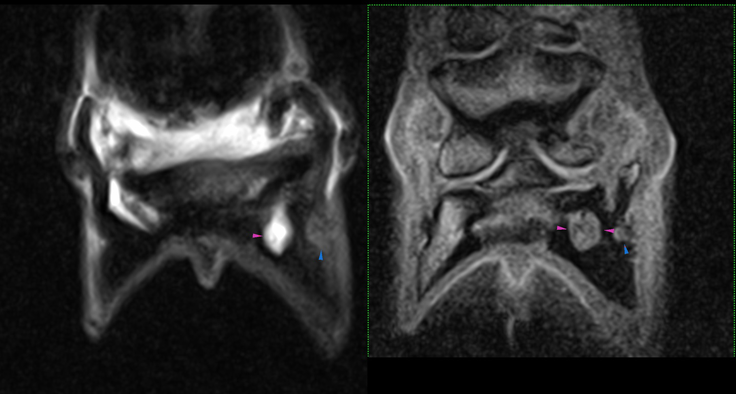
Frontal images of the left hind foot showing the dilated vascular foramen laterally (pink arrows). The dilated vessel coursing laterally along the lateral plantar process of the distal phalanx is indicated by the blue arrows.
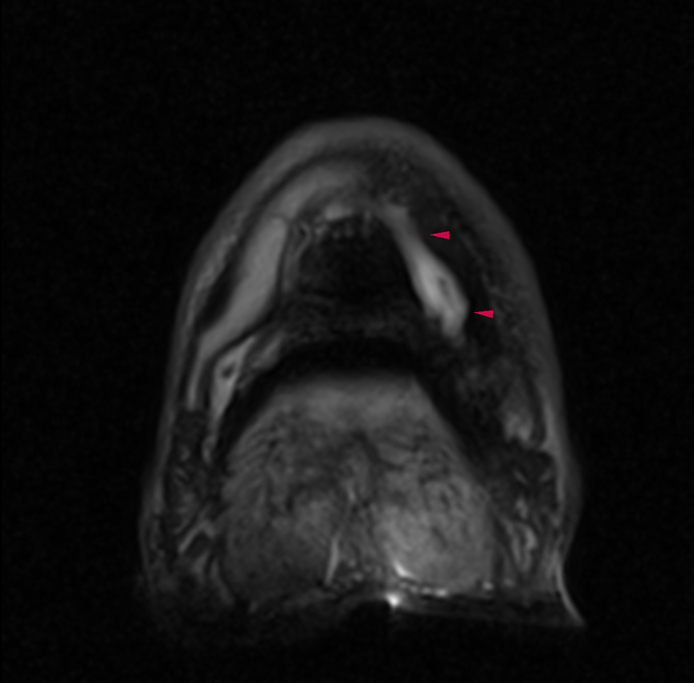
Transverse image of the left hind foot showing the dilated foramen of the proper plantar digital artery.
Given the thickening of the lateral plantar process and the suspected aberrant vascular channels, it was decided to proceed to CT examination of the foot, to give greater osseous detail and delineate the suspected aberrant vascular channels.
CT findings
CT examination confirmed the dilation of the vascular channels of the lateral half of the distal phalanx, with a prominent laterally located channel, which was thought to represent collateral circulation.
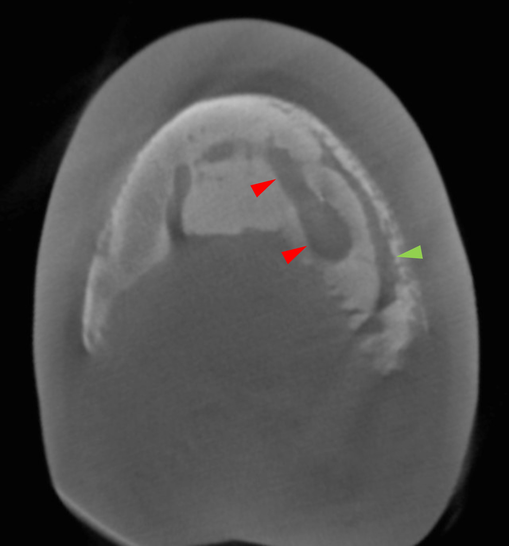
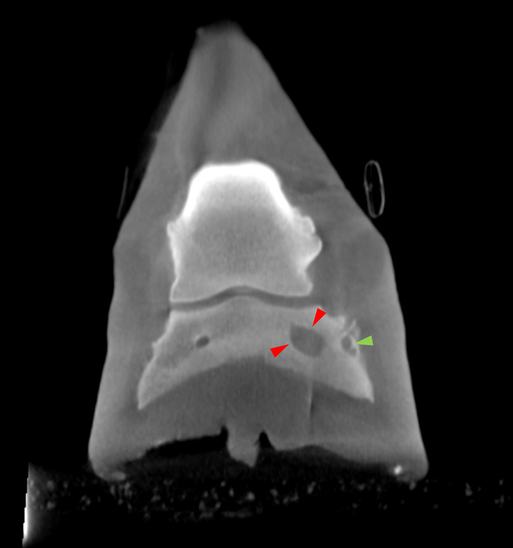
Transverse and frontal images of the foot showing the markedly enlarged lateral portion of the terminal arch (red arrows) and the small collateral vessel (green arrows).
The cause of the marked dilatation of the lateral portion of the terminal arch was not established.
Contrast venography findings
CT angiography was discussed, however this was not possible. Positive contrast venography was carried out, which revealed filling defects in the lateral proper plantar digital artery, extending from the mid point of the terminal arch to the mid diaphysis of the middle phalanx. There remained good contrast filling of the remainder of the lateral vasculature, likely indicating adequate collateral circulation.
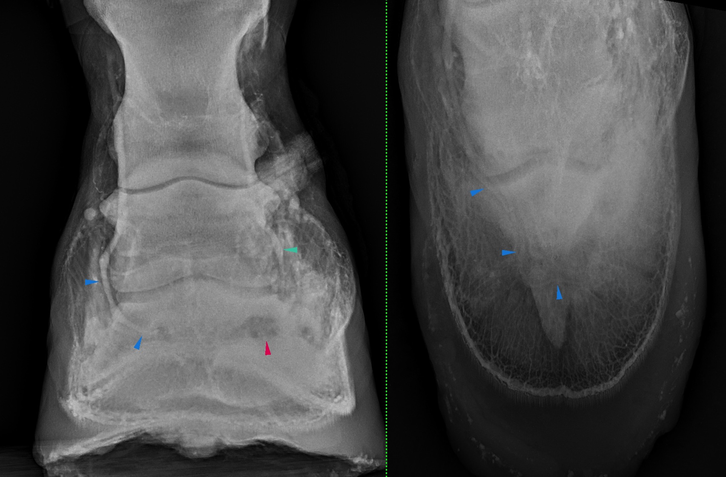
DP and DPrPlDiO views of the left hind foot showing the normal appearance of the medial proper plantar digital artery (Blue arrows). The enlarged lateral foramen is indicated by the red arrow – note that there is no visible contrast within this. The lateral proper digital artery is indicated in the mid diaphyseal region of the middle phalanx (green arrow).
Conclusions
The patient was diagnosed with thrombosis of the lateral proper digital artery with dilatation portion of the terminal arch, which was presumed to be due to pressure necrosis secondary to enlargement of the vasculature.
The MRI and CT showed that the unusual lucency detected radiographically within the distal phalanx represented the lateral portion of the terminal arch. MRI examination showed fluid signal within the bone surrounding this, likely indicating osseous activity. The CT examination confirmed the dilatation of the terminal arch and highlighted the presence of a collateral vessel. The cause of the dilatation was confirmed as thrombosis using venography.
VET.CT Champions Radiation Safety through Global Campaign
VET.CT has launched a campaign to raise awareness about the importance of radiation safety in veterinary practice, providing a comprehensive suite of free resources and real-life case studies to support veterinary teams.
Read morePennard Vets Radiation Safety Case Study
How do real-life practices keep their teams and patients safe during diagnostic imaging? VET.CT sat down with leading clinics to uncover practical, everyday tips that make radiation safety simple and effective.
Read moreQueensland Veterinary Specialists Radiation Safety Case Study
How do real-life practices keep their teams and patients safe during diagnostic imaging? VET.CT sat down with leading clinics to uncover practical, everyday tips that make radiation safety simple and effective.
Read more